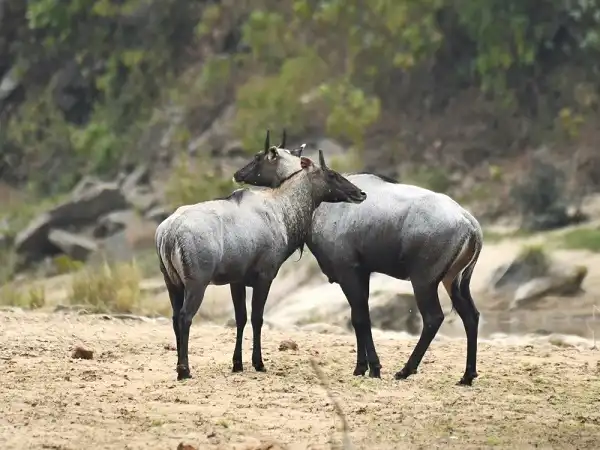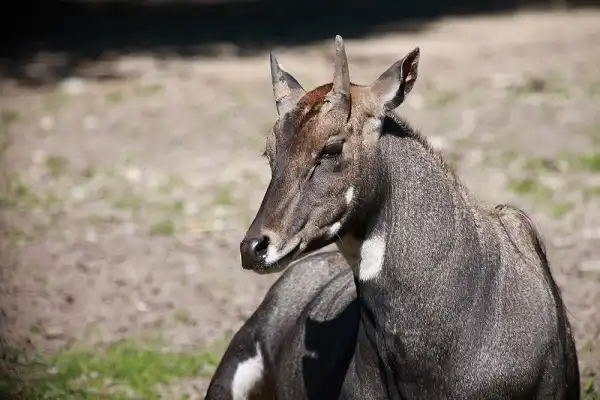Do you know about one of the most fascinating animals found in India, the Nilgai antelope? Also known as blue bulls, these majestic creatures roam across vast grasslands and scrub jungles in a wide range of India’s regions. Despite their size, Nilgi are incredibly fast runners! These antelopes also exhibit surprisingly complex behaviors such as territorial marking and protecting young calves from predators. They provide natural pest control services by eating large amounts of crop-destroying insects while grazing on crops like sorghum or corn. With its strong social bonds between members, Nilgai is an intriguing species that deserves to be studied further!

Nilgai Description
The Nilgai antelope, also known as the blue bull, is a majestic and fascinating animal found in India. These herbivores roam across vast grasslands and scrub jungles in a wide range of India’s regions. Their unique blue-gray coat and strong, muscular build make them a sight to behold. In addition to their speed, Nilgai exhibits a range of complex behaviors. They establish territories and mark them with dung and urine. Males will fight for dominance over these territories during the breeding season. In terms of physical characteristics, the Nilgai is a robust and muscular animal with a sturdy build. Its coat is typically a blue-gray color, with males sporting a darker hue than females. Both sexes have distinctive white markings on their faces and throats, as well as white patches on their bellies and legs.
Nilgai Habitat
The Nilgai antelope, with its remarkable blue-gray coat and strong, muscular build, inhabits various habitats across India, from grasslands to scrub jungles. These majestic creatures are native to the Indian subcontinent, and they have adapted to thrive in a wide range of environments. The Nilgai is primarily found in India, but can also be found in some parts of Pakistan, Nepal, and Bangladesh. They are most commonly found in India’s northern and central regions, including Gujarat, Rajasthan, Madhya Pradesh, and Uttar Pradesh. The Nilgai prefers open grasslands and scrub jungles, but they can also be found in agricultural areas and around human settlements. They are even known to inhabit urban areas on occasion. These antelopes have evolved to be able to tolerate a variety of environmental conditions. They can survive in areas with extreme temperatures, ranging from hot and dry to cold and arid. They are also able to obtain sufficient water through their diet of grass and vegetation.
Nilgai Diet
The Nilgai antelope is an herbivorous species, primarily feeding on grass and vegetation. They have been observed grazing in short grasslands as well as in agricultural fields and even urban areas. In addition to their diet of grass and vegetation, Nilgai also feed on fruits, buds, leaves, shoots, and pods. They are especially fond of succulent young leaves which provide them with the most nutritional value. Nilgai can often be found grazing near water sources where they can find fresh green grasses that contain the highest amounts of proteins and minerals. They typically forage for food in the morning or evening hours when temperatures are lower. These antelopes also eat large quantities of crop-destroying insects, providing farmers with a natural pest control service.

Nilgai Size
The Nilgai antelope is a large and imposing mammal, typically measuring between 1.2 and 1.5 meters in height at the shoulder. Adult males can weigh anywhere from 180 to 240 kilograms, while females tend to be slightly smaller, weighing between 120 and 220 kilograms. An interesting fact about the Nilgai is that they are the largest antelope species found in Asia. This makes them an important part of the ecosystem in the areas where they live because they serve as keystone species, playing a vital role in maintaining the health and balance of their environment. Despite their impressive size, the Nilgai is known for its agility and speed. These animals are capable of running at speeds of up to 50 kilometers per hour, which allows them to escape from predators such as wolves and tigers.
Nilgai Lifespan
The lifespan of Nilgai antelopes in the wild is estimated to be around 12-15 years. However, in captivity, they have been known to live up to 21 years. Various factors can influence the lifespan of these animals, including the availability of food and water, the presence of predators, and the impact of human activities such as hunting and habitat destruction. Interestingly, Nilgai is known to have a slow reproductive rate, with females only giving birth to a single calf at a time. This reproductive strategy may contribute to their longevity, as they are able to invest more energy and resources into the survival and well-being of each individual offspring. In addition, like many herbivorous animals, Nilgai has a low metabolic rate, which may also contribute to their lifespan. A lower metabolic rate allows for a slower rate of cellular aging, reducing the impact of oxidative stress and other factors that can contribute to aging and disease. Overall, while the lifespan of Nilgai in the wild may be relatively short compared to other large mammals, they are able to live for many years and make important contributions to their ecosystem during their lifetime.
Nilgai Behavior
Besides their physical characteristics and diet, the behavior of the Nilgai antelope is also fascinating. These animals are known for their social, gregarious nature and often form large herds, especially during the dry season when resources such as food and water may be scarce. Within these herds, Nilgai has a hierarchical social structure. Dominant males, also known as bulls, establish their position through displays of aggression and intimidation toward other males. Females, on the other hand, tend to be more cooperative and form close-knit groups with other females and their young. Nilgai is primarily diurnal, which means they are active during the day and rest at night. During the hottest parts of the day, they may seek shade or rest in more sheltered areas to avoid the heat.
These animals are also known for their territorial behavior and may mark their territory with scent marks and other visual cues to indicate ownership and deter other Nilgai from encroaching on their space. Interestingly, despite their social nature, Nilgai is not highly vocal animals. They communicate primarily through body language and scent marking, using their distinctive white patches and other visual cues to convey information to other members of their herd. The behavior of the Nilgai antelope is complex and multifaceted. These animals are highly social and form tight-knit herds, but also have a hierarchical social structure and defend their territory fiercely.

Nilgai Speed
Nilgai are known for their impressive speed and agility, which are important factors in their ability to survive in the wild. They are able to run at speeds of up to 30 miles per hour, which allows them to outrun many predators and avoid danger. Their powerful legs and sharp hooves also contribute to their speed, enabling them to quickly change direction and navigate through varied terrain. Despite their larger size, Nilgai is surprisingly nimble and can easily maneuver through dense vegetation and rocky terrain. They are able to leap over obstacles and navigate steep slopes with ease, making them well-suited to a wide range of habitats. In addition to their impressive speed and agility, Nilgai is also known for their endurance. They are able to sustain a fast pace for extended periods of time, which contributes to their ability to evade predators and cover long distances in search of food and water.
Nilgai Reproduction
The Nilgai antelope is a polygynous species, meaning males will typically form harems and mate with multiple females. These animals usually reach sexual maturity between the ages of 2 and 4 years old. The mating season typically takes place in late summer or early winter, when temperatures are cooler. During this time, the males become aggressive, bellowing and making other loud vocalizations as they compete for female attention. Females often give birth to 1 or 2 calves after a gestation period of about 8 months. The calves are able to stand on their own within minutes of being born and can follow their mother around only a few hours later.
Nilgai Hunting
Despite their impressive speed and agility, Nilgai has unfortunately become a target for hunting in some regions. In certain parts of their range, they are considered a nuisance species due to their impact on crops, which has led to increased hunting pressure. This has caused a decline in their population in some areas, making conservation efforts all the more important. Furthermore, hunting Nilgai can also be detrimental to local ecosystems, as these animals play an important role in maintaining balance and diversity. In addition, hunting Nilgai can be a dangerous pursuit due to their territorial behavior and ability to defend themselves. While they may not be highly aggressive towards humans, they can inflict serious harm with their sharp hooves and powerful legs. Efforts are being made to regulate the hunting of Nilgai and protect their populations, with some areas implementing strict quotas and regulations for hunting.

Conclusion
The Nilgai antelope is an impressive species that has adapted to a wide range of environments and is incredibly resilient in the face of danger. With their social behavior, speed, agility, and territorial nature, they are an important part of many ecosystems in Asia. Unfortunately, hunting pressure and habitat destruction have caused declines in some areas. Conservation efforts such as protected areas and education on coexistence with wildlife can help to protect this majestic species for future generations.
Frequently Asked Question


